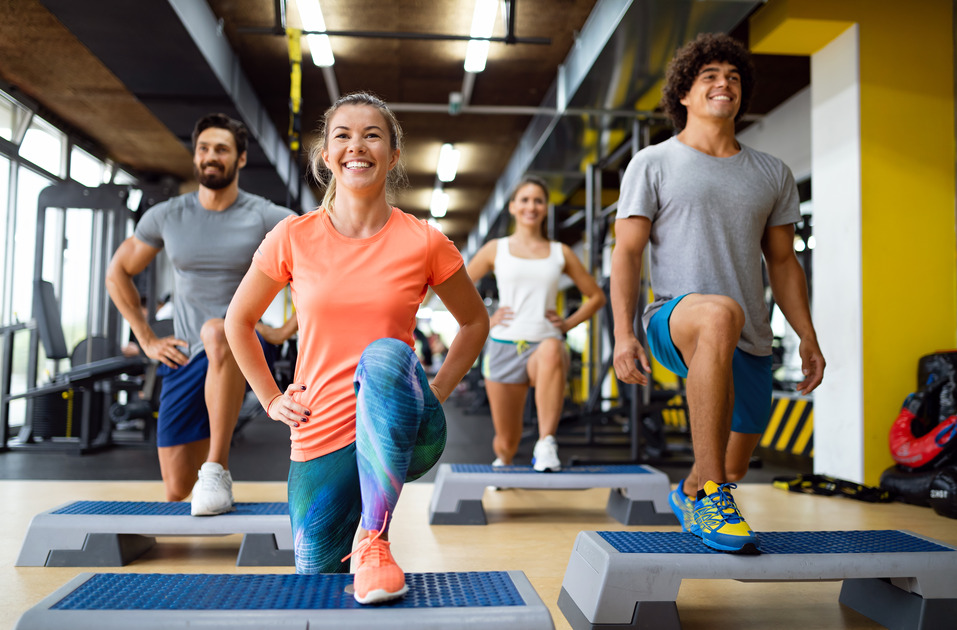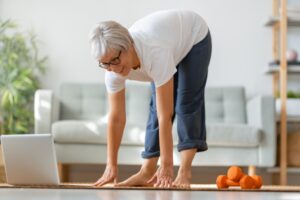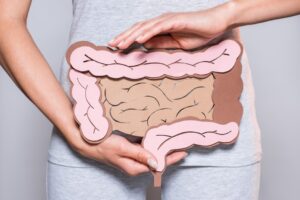Staying active isn’t just about feeling young – science suggests it can literally slow down your body’s internal “molecular clock” of aging, sciencedaily.com. Recent research on epigenetic aging (biological aging measured by DNA markers) found that structured exercise, like regular aerobic and strength training, has a stronger anti-aging impact than casual physical activity. In both animal studies and human trials, consistent workouts led to measurable reductions in biological age, meaning exercise didn’t just tone muscles – it also helped keep cells and tissues youthful across the body.
Regular exercise can help slow the body’s aging clock, keeping people feeling more youthful inside and out. Studies show that staying fit isn’t only about muscles – it can slow aging in vital organs and even at the DNA level. Physical activity influences how our cells age deep down, so hitting the gym or going for that run might help keep your heart, liver, and other organs “younger” than your calendar age would suggest. Researchers have observed that individuals who maintain high physical fitness tend to show fewer molecular signs of aging in multiple tissues, highlighting exercise’s broad anti-aging benefits aging-us.com.
Understanding Your Body’s Molecular Aging Clock (Epigenetic Aging)
To grasp how exercise might reverse aging, it helps to understand epigenetic aging – essentially, your body’s internal aging clock. Epigenetic aging refers to chemical changes in your DNA (such as DNA methylation patterns) that indicate how fast your cells are aging at the molecular level. Scientists use epigenetic clocks to measure this by tracking specific DNA modifications that accumulate with age. Unlike your chronological age – the number of birthdays you’ve had – your epigenetic (biological) age reflects the wear-and-tear on your cells and organs. This molecular age can be faster or slower than your calendar age, depending on factors like diet, stress, and, importantly, lifestyle habits such as exercise. A younger epigenetic age means your cells are behaving as if they’re in a more “youthful” state, which is generally linked to better health and longevity.
Researchers have found that lifestyle choices can dial this biological clock forward or back. And among lifestyle factors, exercise stands out as a powerful lever. By influencing gene activity and improving cellular function, regular exercise essentially tells your body to age more slowly. The result is a body that not only feels younger but, on a cellular level, is younger than it would be without exercise.
Why Structured Exercise Matters More Than Casual Activity
Not all physical activity is equal when it comes to slowing aging. General everyday activities – walking the dog, doing housework, taking the stairs – do help health, but structured exercise routines appear to provide far stronger anti-aging effects sciencedaily.com. Structured exercise means planned, repetitive workouts done with a goal (for example, a set running or weight training program). In a new research review, scientists highlighted that these purposeful exercise sessions have a greater impact on slowing epigenetic aging than the light activity we get just moving through our day. The key difference is intensity and consistency: moderate to vigorous exercise triggers deeper changes inside our cells that casual movement doesn’t.
In particular, maintaining high cardiorespiratory fitness (think strong heart and lung capacity from regular aerobic training) is closely linked to a slower epigenetic aging rate. In other words, people who push their cardiovascular system through structured workouts often have cellular markers that indicate a younger biological age than their less-fit peers. While any movement is better than none, challenging your body with regular exercise seems to be the best way to keep your DNA’s aging clock ticking more slowly.
This doesn’t mean you need to become a marathon runner overnight. It’s about consistency and progression – for example, following a weekly schedule of cardio and strength training. Over time, those structured workouts act like deposits in your “youthfulness” bank account, building up resilience in your cells. So, while a casual evening stroll is great for clearing your mind, a well-planned workout routine will do more to turn back the clock on a molecular level.
Turning Back the Clock: What the Research Shows
Scientists have been digging into how exercise affects biological age, and the findings are exciting. In studies with mice, researchers found that structured endurance and resistance training actually reversed some age-related molecular changes in muscle tissue. Essentially, older mice that exercised had muscle cells that looked younger and healthier under the microscope than those of sedentary mice. This gave scientists a big clue that exercise directly influences the aging process in tissues.
Even more compelling is evidence from human studies. Multiple trials have shown that regular exercise can make your biological age markers drop, meaning your cells start to act younger than before. In one notable study, a group of previously sedentary middle-aged women undertook an eight-week program of combined aerobic and strength training. The result? On average, they knocked about two years off their epigenetic age in just those two months. By the end of the trial, their blood and muscle tissue indicated they were biologically younger than when they started – a remarkable change in a short time frame.
Another study looked at older men and found that those with higher VO₂ max (a measure of aerobic fitness, basically how well their bodies use oxygen during intense exercise) had significantly slower epigenetic aging than those with lower fitness. This suggests that being in good cardiovascular shape correlates with a younger biological profile. It’s not just short-term exercise programs at play, either – long-term fitness matters as well. Researchers have observed that elite athletes, such as Olympic competitors who have trained for years, tend to have a lower biological age than non-athletes of the same chronological age. Their lifelong intense physical activity seems to have kept their molecular aging at bay.
Importantly, you don’t have to be an Olympian to reap these benefits. Even people with chronic health conditions who improve their fitness level see signs of slower biological aging compared to less active individuals with similar conditions, earth.com. In other words, when it comes to keeping your cells young, anyone can benefit from exercise. The men and women in these studies – whether middle-aged and out of shape, older with health issues, or at the peak of athletic competition – all showed that upping physical activity can slow down how fast their bodies were aging on the inside.
As the authors of the new report summed up, “maintaining physical fitness delays epigenetic aging in multiple organs”, essentially acting as a geroprotector – a protector against aging – for various parts of the body. In plain terms, exercise helps shield not just your muscles but your whole system from the ravages of time. These findings collectively drive home a powerful point: staying active is one of the most effective tools we have to turn back our biological clock.
Benefits Beyond Muscles: A Whole-Body Anti-Aging Effect
One of the striking insights from recent research is that exercise’s anti-aging effects aren’t limited to the muscles you flex in the gym – they extend throughout the body. While much early research focused on skeletal muscle (since that’s obviously impacted by exercise), scientists now have evidence that regular training slows aging in the heart, liver, and even fat tissue. Your cardiovascular system, for instance, responds to exercise with improved blood flow and molecular changes that keep heart cells younger. The liver, which plays key roles in metabolism and detoxification, also appears to age more slowly in physically active individuals, according to animal studies and human data. Even adipose (fat) tissue shows fewer inflammatory aging signals in people who exercise often, which could translate to lower risks of metabolic problems.
Perhaps most surprisingly, there are hints that exercise benefits the gut as well. Emerging research suggests that working out might positively influence your gut microbiome – the community of microbes in your intestines – which in turn can affect aging and health. A healthy, diverse gut microbiome has been linked to slower aging and better immune function, and exercise seems to nurture that kind of gut environment. So, the effect of your daily run or weightlifting session could ripple out to even the bacteria in your belly, creating a broad network of age-fighting benefits.
It’s clear that exercise doesn’t just give you strong muscles – it rejuvenates multiple systems. From your cardiovascular system to your digestive system, staying fit helps each part of you function as if it were younger. This whole-body impact is what makes exercise such a powerful strategy in healthy aging. You’re not just gaining strength or endurance when you work out; you’re also potentially giving your heart, liver, fat cells, and gut a new lease on life, at least in molecular terms. By keeping these organs youthfully tuned, exercise can help reduce the risk of age-related diseases across the board – from heart disease to diabetes to cognitive decline.
Personalizing Exercise: Why Some People Respond Differently
If exercise is so great at slowing aging, a curious observation remains: not everyone responds in the same way. You might have noticed this anecdotally – maybe you and a friend started a workout program together, but only one of you saw dramatic changes in health markers. Scientists have noticed similar variability in their data. Some individuals experience a big drop in biological age from exercise, while others get a more modest effect. The recent research calls for further investigation into why some people’s bodies respond more strongly to exercise than others, sciencedaily.com. There are many possible reasons for this difference. Genetics likely play a role – certain gene variants might make one’s cells more receptive to the benefits of exercise. Baseline health and epigenetic state could be another; intriguingly, one report noted that people with a higher biological age (meaning their cells were older than expected for their age) tended to benefit most from exercise intervention,s earth.com. It’s as if those who need it most get the biggest kick. But why that is “remains unclear,” as researchers admit.
Another factor could be the type of exercise. Some individuals might respond better to endurance training, while others get more benefit from strength training or high-intensity intervals. The interplay of exercise type, frequency, and individual biology is complex. This is why experts emphasize developing personalized exercise programs – regimes tailored to an individual’s unique makeup and needs. A one-size-fits-all approach might not maximize the anti-aging benefits for everyone. For example, someone who doesn’t respond much to a standard cardio routine might do better with a high-intensity strength program, or vice versa.
Researchers have identified key challenges to maximizing exercise’s anti-aging benefits – notably, the unexplained differences in how individuals respond to training and how various workout types affect different organs. One person might see dramatic improvements in their “biological age” with a certain workout plan, while another sees only slight changes. Scientists are trying to map out these individual variations so that in the future, exercise as medicine can be tailored to each person’s biology. By pinpointing why and how exercise works at the molecular level for different people, they aim to design training programs that give everyone the biggest anti-aging bang for their buck. They also note that new analytical tools (like advanced causal epigenetic clocks) are in development to help confirm that exercise is directly causing these youthful changes in our DNA and not just associated with them, earth.com. In other words, the research community is working hard to answer the remaining questions: Who benefits the most, what is the optimal exercise “dose” for each person, and will these cellular changes truly add up to longer, healthier lives?
The Bottom Line
All evidence points to one conclusion: exercise is one of the most potent tools we have to slow down aging from the inside out. Regular structured exercise – be it jogging, swimming, weightlifting, or your favorite fitness class – doesn’t just keep you fit and strong. It actually touches every corner of your body, sending signals that preserve the youth of your cells, your organs, and even your DNA. While scientists are still unraveling the finer details (like why individuals differ in response and how long the effects last), the take-home message is already clear. Staying physically active and building your fitness is an investment in a younger you. It’s never too late to start: every workout is a message to your body to keep its aging clock ticking slower. So next time you lace up your sneakers or hit the gym, remember – you’re not just improving your mood or your waistline, you might literally be turning back time within your body. Embrace that structured exercise routine, and your future self will thank you for the extra years of vitality.





